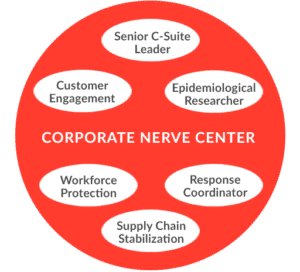
How to Create a COVID-19 Task Force
To facilitate an agile response to the pandemic, learn how to form central teams dedicated to pandemic response, known as COVID-19 task forces.

As everyone is learning during the coronavirus outbreak, pandemics are a unique type of threat. They last for months, provide new insights every week, and require organizations to adapt every day. With pandemics, it is more important than ever to be vigilant and proactive in your company’s response.
To facilitate this agile response, many companies have decided to form central teams dedicated to pandemic response, known as COVID-19 task forces. Management experts like McKinsey and Company recommend this approach because a small, central team is most likely to develop the creative, pragmatic solutions that a pandemic requires.
Purpose of a COVID-19 Task Force
The COVID-19 task force is essentially your organization’s hub for big-picture, pandemic-related planning. The team should meet regularly—digesting the most up-to-date information about the pandemic and translating that into a course of action. Essentially, the job of the COVID-19 task force can be broken down into three key activities:
Assess
First, the team needs to constantly assess the situation as it evolves. Pandemics change course every week—sometimes every day—and the COVID-19 task force needs to be on the front lines of the latest information.
Here are questions the task force should be asking:
- What measures are health experts recommending to minimize the risk of infection?
- How is the disease known to spread?
- What are other companies in our industry doing to adapt?
- What are the latest guidelines from federal, state, and local governments?
- How do experts forecast the pandemic is going to progress?
The answers to these questions will inform the next step of your team’s response.
Act
After assessing the situation, your team needs to decide the practical steps your company needs to take in response. These actions should span the entire scope of your business.
Consider whether your company should alter:
- Remote working policies
- Business travel
- Pricing
- Supply chain
- Marketing messaging
- Product delivery
- Budget
This will involve difficult decisions, and it may be tempting to delay necessary proactive measures at the risk of being too hasty. Because of the nature of a pandemic, though, precautions that seem like overreactions in the moment will prove to be 100% necessary weeks later. Always err on the side of caution—especially when it comes to keeping your employees healthy.
Adjust

Finally, your team should consistently monitor the actions you have already taken. Are they working in the way you had planned? Are there ways to make them more effective?
Pandemic response is a constant cycle of action and adjustment. In addition to assessing the external environment, it is just as important to assess your company’s response.
This is the third aspect of the task force’s purpose—but the process doesn’t end there. Adjustment should lead right back into the first step, assessing the environment. The point is, this is an iterative process, where new information leads to new actions and new adjustments.
Structure of a COVID-19 Task Force
Because the task force will be a decision-making hub for actions spanning your entire business, it is crucial that the team has a representative for each key stakeholder. Described below is the basic structure you should try to emulate.
Larger organizations may employ a more complex structure, where each representative in the core team reports back to a sub-team focused on that aspect of your company’s response. For smaller organizations, a single six-person team should suffice. Regardless, your company’s core team should roughly follow this structure.
 Senior C-Suite leader
Senior C-Suite leader
This role needs to provide senior leadership and big-picture perspective to the task force. In most organizations, this will be the CEO. But in some organizations, it may be more appropriate to have the CFO or COO fill this role—depending on the company’s broader decision-making structure.
Regardless, this person should have a comprehensive understanding of how your business operates—plus the seniority to sign off on the task force’s key initiatives. This person should represent the interests of senior, C-suite leadership on the team.
Epidemiological researcher
It is also critical that your task force has someone with an in-depth knowledge of the disease. It is important to note, however that this role does not require special training or education. All the information this person needs is publicly available from trusted sources like the CDC and WHO, and from health experts like Dr. Anthony Fauci. Rather than being an expert themselves, this person should take the time to follow the latest advice and updates from people who are experts.
The researcher role can be filled by someone from any department. Most importantly, it should be someone who is a strong communicator and is willing to take the time necessary to stay up-to-date on the disease’s latest developments.
Supply chain stabilization
Your task force should also have someone who is intimately familiar with your organization’s supply chain. The pandemic has already caused large-scale supply chain disruptions, and experts warn that the worst is still to come.
This person needs to have a big-picture understanding of how your company’s supply chain works. He/she should provide updates to the team on the state of the supply chain and make recommendations when remedial action is necessary.
Customer engagement
Engaging with customers is a critical aspect of pandemic response. The tone of your marketing material will almost certainly need to change significantly, and you may also need to communicate major changes (e.g. regarding product delivery, pricing) to customers. Most importantly, your customers need to know that you are aware of the crisis and are taking the necessary steps to keep them and your employees safe.
This role should be filled by someone with a deep understanding of your customers, likely your head of sales or marketing. This person should advocate for customers and take the lead when it comes to issues regarding customer engagement.
Workforce protection
Keeping your people safe is the most important job of the COVID-19 task force. The team needs someone fully dedicated to that cause. This person should take the lead on conversations regarding employee safety, remote working, and workplace health concerns.
If your company has a role or department dedicated to employee safety, then look there first to fill this role. Otherwise, it likely makes the most sense to choose a senior Human Resources manager. They will best understand your company’s current policies in these areas and be able to speak to how they can change.
Response coordinator
Finally, your COVID-19 task force needs a person dedicated to coordinating your response. This person’s most important job will be communication. Whenever your task force makes a decision, it will have a ripple effect throughout your organization. Your response coordinator should be in charge of leading the way regarding internal messaging and aligning the different departments with each new initiative.
This role should be filled by your company’s head of Human Resources. HR is the one department that works regularly with every other department, making them the best equipped to coordinate your company’s response.
It is also critical that this person is comfortable using your company’s emergency communication system. This process will require constant communication—to your entire organization, to specific offices, to specific employees. The only way to prevent this from devolving into chaos is to house all pandemic-related internal communication in your emergency communication system. Your response coordinator must be comfortable using this system.
Equipping Your COVID-19 Task Force
The final step in creating your task force is equipping them to succeed. For one, this means giving the team as much decision-making autonomy as possible. The point of the task force is to give your organization the potential to have a rapid response and remain agile through a constantly evolving pandemic. It will undercut the purpose of the team if decisions they make get hung up in levels of bureaucracy before going into implementation.
Plus, you need to make sure that your task force is equipped to communicate its initiatives to the relevant sub-teams—and the company as a whole. You cannot rely on massive email distribution lists or phone trees to facilitate this communication. If you haven’t already, implement a multi-channel, two-way emergency communication system, which will streamline your company’s response and keep everyone on the same page with the decisions your task force is making.




